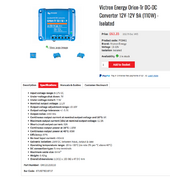Hi,
I'm working on a offgrid system of direct to PV components.
In this case, a 35W water pump to circulate nutrients to tomato plants in our greenhouse.
The project does not justify the cost of batteries, expensive controllers etc. and I'm allergic to unnecessary complexity!
Most 'redneck' direct to PV pump systems match panel output to pump input (35w PV to 35w Pump etc.) to avoid burnout.
The problem here is that my panels will normally output less than half their capacity - leaving the pump underpowered.
Continuous pumping is not vital as the header tank provides a buffer by gravity feed in the greenhouse, but I feel the pump might eventually fail under a low stuttering supply.
My thought was to over panel (100watts) and then limit the current (somehow) to 35 watts. That way the panel would only need to work at 30% efficiency to properly power the pump.
Would a simple 100watt variable resistor achieve this? Or am I missing something?
 .
.
I'm working on a offgrid system of direct to PV components.
In this case, a 35W water pump to circulate nutrients to tomato plants in our greenhouse.
The project does not justify the cost of batteries, expensive controllers etc. and I'm allergic to unnecessary complexity!
Most 'redneck' direct to PV pump systems match panel output to pump input (35w PV to 35w Pump etc.) to avoid burnout.
The problem here is that my panels will normally output less than half their capacity - leaving the pump underpowered.
Continuous pumping is not vital as the header tank provides a buffer by gravity feed in the greenhouse, but I feel the pump might eventually fail under a low stuttering supply.
My thought was to over panel (100watts) and then limit the current (somehow) to 35 watts. That way the panel would only need to work at 30% efficiency to properly power the pump.
Would a simple 100watt variable resistor achieve this? Or am I missing something?
 .
.


